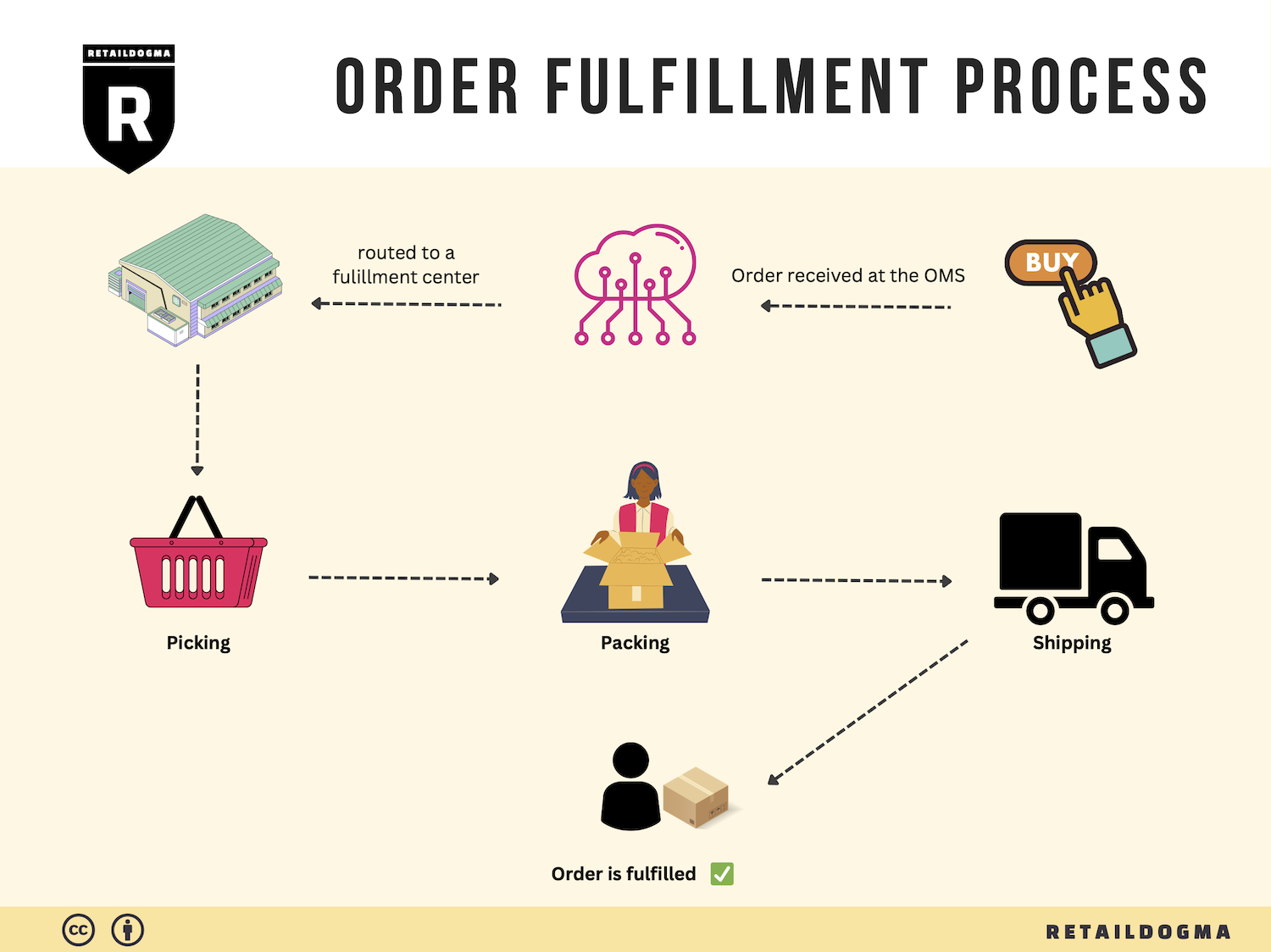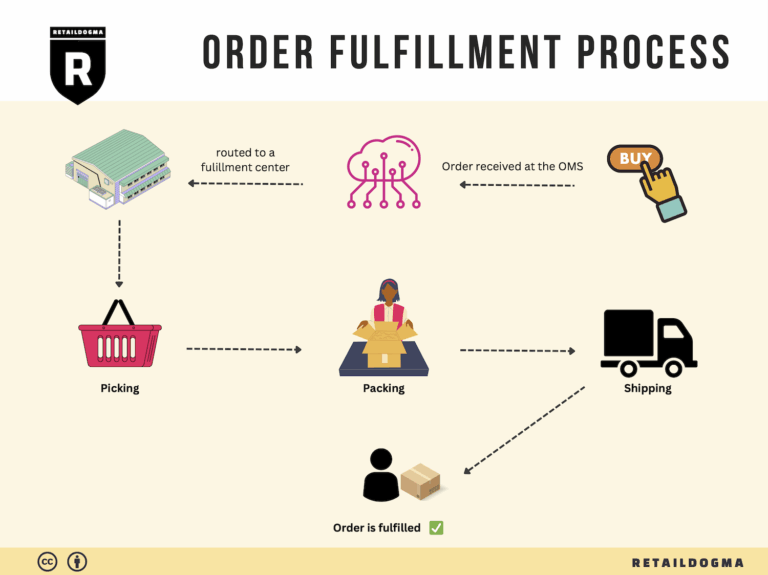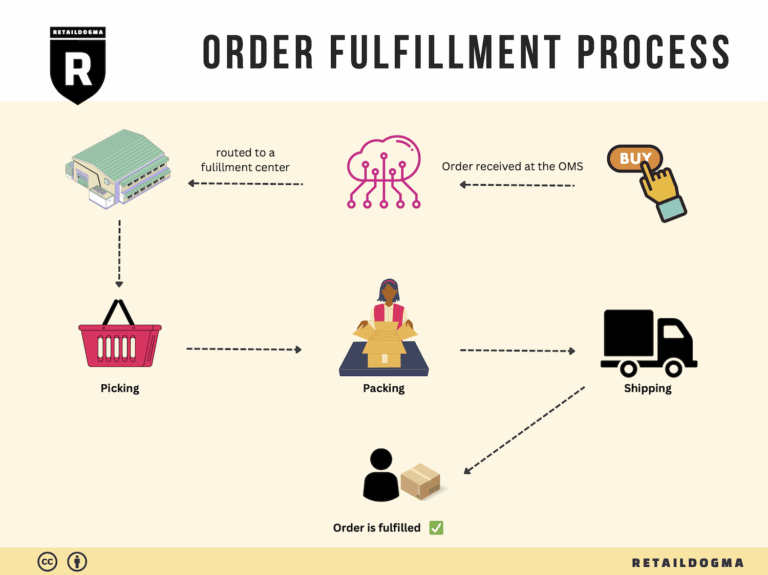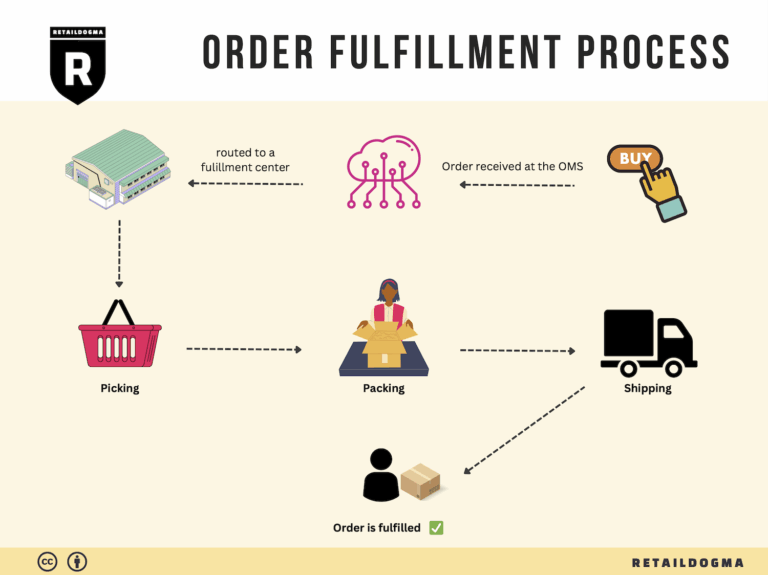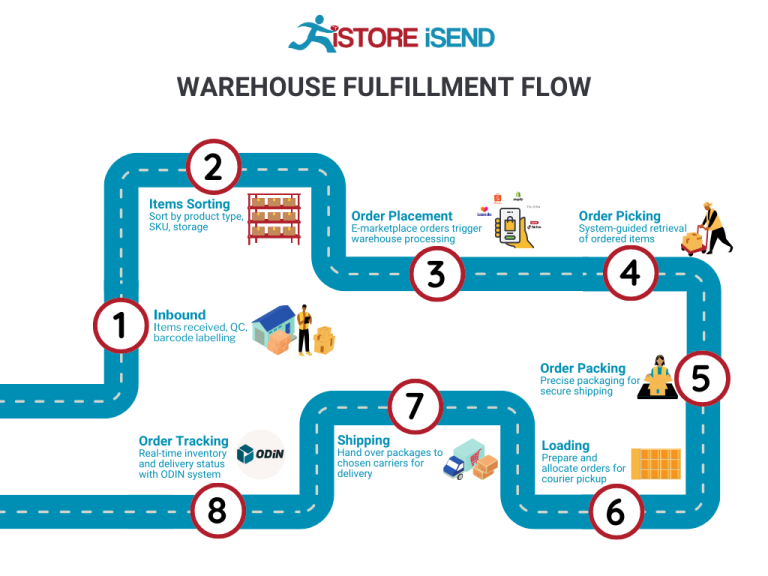How Order Fulfillment Works: A Step-by-Step Guide for Businesses
What is E-commerce Fulfillment? An Introduction for Growing Businesses
Understanding E-commerce Fulfillment
As an e-commerce business owner, you know that managing order fulfillment can quickly become overwhelming. The excitement of receiving orders can swiftly turn into stress when faced with the logistics of packing, shipping, and managing customer expectations. The fulfillment process—getting a product from your warehouse to a customer’s doorstep—can be complex and resource-intensive, often consuming valuable time that could be better spent on growing your business.
E-commerce fulfillment encompasses the entire journey of a product after a customer places an order. This includes inventory management, order processing, packing, shipping, and handling returns. Efficient fulfillment is crucial for maintaining customer satisfaction and loyalty, especially as your business scales. In fact, poor fulfillment can lead to lost sales, negative reviews, and ultimately, a damaged brand reputation.
In this guide, we will explore the various fulfillment models available to growing businesses, including Fulfillment by Amazon (FBA) and Third-Party Logistics (3PL). Each model has its own set of advantages and challenges, and understanding these can help you choose the right approach for your unique business needs.
We will cover the core services associated with e-commerce fulfillment, such as inventory management, order processing, and shipping options. Additionally, we will discuss how to select a fulfillment partner that aligns with your business goals, including factors to consider like scalability, technology integration, and customer service capabilities.
Pricing is another critical aspect we will address. Understanding the costs associated with different fulfillment models will empower you to make informed financial decisions that directly impact your bottom line. We will break down common pricing structures, including fulfillment fees, storage costs, and shipping charges, helping you to anticipate and manage expenses effectively.
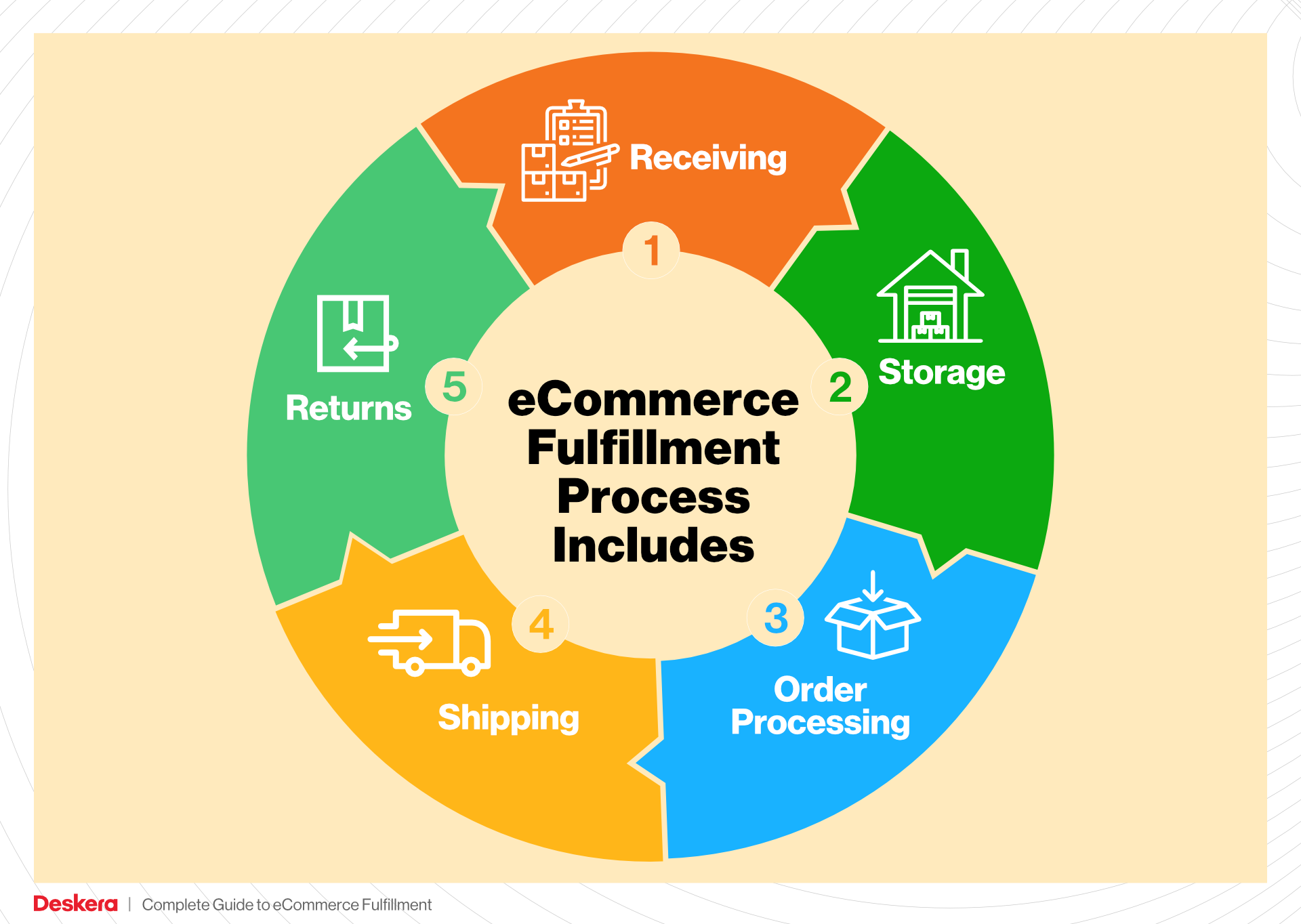
The ultimate goal of this guide is to empower you to make smart, strategic decisions about your logistics and fulfillment processes. By gaining a comprehensive understanding of e-commerce fulfillment, you can optimize your operations, enhance customer satisfaction, and position your business for sustainable growth. Let’s dive in and unlock the potential of efficient fulfillment for your e-commerce success.
What You’ll Learn In This Guide
- What is E-commerce Fulfillment? An Introduction for Growing Businesses
- The Order Fulfillment Process: From ‘Buy’ Button to Customer’s Door
- Comparing Fulfillment Models: In-House vs. 3PL vs. Dropshipping
- A Deep Dive into Amazon FBA: Pros, Cons, and Who It’s For
- Core Services Offered by Fulfillment Centers
- How to Choose a Fulfillment Partner: A 6-Point Checklist
- Understanding Fulfillment Pricing: A Breakdown of Common Fees
- Frequently Asked Questions (FAQs) about Fulfillment
- Conclusion: Is Outsourcing Fulfillment the Right Move for Your Business?
- Important Disclaimer
The Order Fulfillment Process: From ‘Buy’ Button to Customer’s Door
1. Receiving Inventory
The order fulfillment process begins with receiving inventory. When products arrive at the fulfillment center, they must be checked for accuracy and quality. This involves verifying that the received items match the purchase order and inspecting them for damage. Proper inventory management systems, often utilizing Stock Keeping Units (SKUs), are critical at this stage. Each product is assigned a unique SKU, which helps streamline tracking and organization.
Why is this step important? Accurate receiving ensures that the inventory recorded in the system reflects what is physically available. Any discrepancies can lead to stockouts or overstock situations, both of which negatively impact customer satisfaction and cash flow. Additionally, a well-organized receiving process helps minimize the time products spend in transit, allowing for faster order fulfillment.
2. Warehouse Storage
Once inventory is received and verified, it is moved to the warehouse storage area. This step involves organizing products in a manner that maximizes space and accessibility. Efficient warehouse management systems often employ a method called slotting, which assigns products to specific locations based on their size, demand, and turnover rates.
The importance of this step cannot be overstated. Well-organized storage not only reduces the time required to locate products but also minimizes handling errors. When products are stored logically, it enhances the overall efficiency of the fulfillment process, allowing for quicker order processing. A well-executed storage strategy can lead to significant cost savings and improved service levels.
3. Order Picking
The next step is order picking, where items are selected from the warehouse to fulfill customer orders. This process typically begins when a customer clicks the ‘buy’ button, triggering a pick list that details which items need to be gathered. Efficient picking methods, such as batch picking or zone picking, can significantly reduce the time it takes to gather products.
Order picking is critical because it directly influences the speed and accuracy of order fulfillment. Errors made during this stage can lead to incorrect shipments, resulting in customer dissatisfaction and costly returns. By employing technology, such as handheld scanners or automated picking systems, businesses can enhance accuracy and efficiency, ensuring that the right products are sent to the right customers.
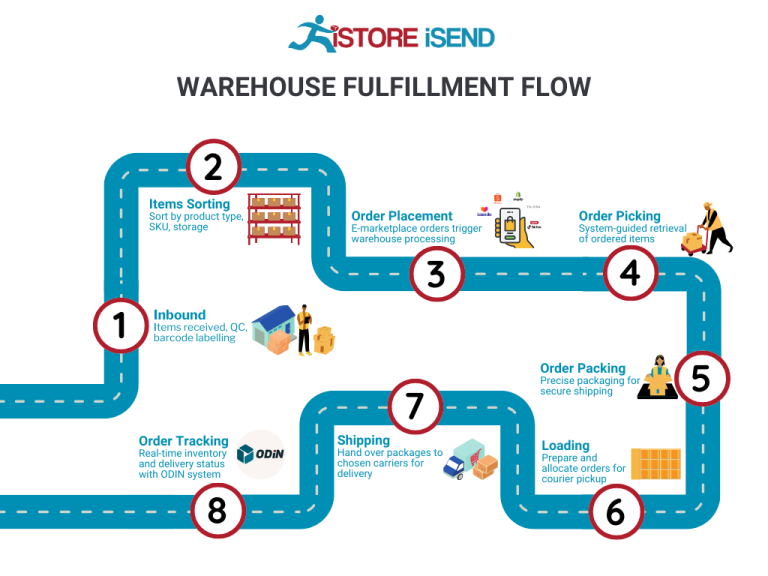
4. Order Packing
After items have been picked, they move to the order packing stage. Here, products are securely packaged to prevent damage during transit. This step often involves choosing the right packing materials and including any necessary documentation, such as invoices or return labels. Businesses may also utilize packing slips, which provide a summary of the order contents for both the customer and the fulfillment team.
The packing stage is vital for customer satisfaction and cost management. Properly packed orders reduce the likelihood of damage during shipping, which can lead to costly replacements and unhappy customers. Additionally, a well-designed packing process can optimize shipping costs by minimizing dimensional weight and ensuring that the right size box is used for each order.
5. Shipping & Delivery
The final step in the order fulfillment process is shipping and delivery. Once orders are packed, they are handed over to carriers for transportation. This stage involves selecting the most efficient shipping method, whether it be standard, expedited, or international shipping. Key terms like tracking numbers come into play, allowing both the business and the customer to monitor the shipment’s progress.
Shipping and delivery are crucial for customer retention. Fast and reliable shipping can be a significant differentiator in the competitive e-commerce landscape. Customers increasingly expect quick delivery times, often influenced by giants like Amazon. Businesses that can meet or exceed these expectations will likely see increased customer loyalty and repeat purchases. Moreover, maintaining clear communication regarding shipping timelines and tracking information enhances the customer experience, fostering trust and satisfaction.
In summary, the order fulfillment process consists of critical steps that, when executed effectively, contribute to a seamless customer experience. From receiving inventory to ensuring timely delivery, each phase plays a vital role in the overall efficiency of e-commerce operations. By understanding and optimizing these processes, businesses can position themselves for growth and success in the ever-evolving marketplace.

Comparing Fulfillment Models: In-House vs. 3PL vs. Dropshipping
Fulfillment Models Overview
Choosing the right fulfillment model is crucial for e-commerce businesses looking to scale operations effectively. Each model—In-House Fulfillment, Third-Party Logistics (3PL), and Dropshipping—has its own set of characteristics, advantages, and disadvantages. Below is a comparative table to help you understand the key differences.
| Model | Who Handles Inventory | Best For (Business Stage) | Key Advantage | Key Disadvantage |
|---|---|---|---|---|
| In-House Fulfillment | Business itself | Established businesses | Complete control over inventory and processes | High operational costs and resource demands |
| Third-Party Logistics (3PL) | 3PL provider | Growing businesses | Flexibility and scalability without heavy investment | Potential loss of control over customer experience |
| Dropshipping | Supplier | Startups or new entrants | Low upfront costs and minimal risk | Lower profit margins and reliance on suppliers |
In-House Fulfillment
In-House Fulfillment involves managing all aspects of inventory and shipping within your own facilities. This model is ideal for established businesses that have the resources to handle logistics efficiently. The key advantage of in-house fulfillment is the complete control it offers over inventory management, order processing, and customer service. Businesses can tailor their operations to their specific needs, ensuring a personalized experience for their customers.
However, this model comes with significant drawbacks. High operational costs are often associated with maintaining warehouse space, hiring staff, and managing logistics. Additionally, businesses must invest in technology and systems to track inventory and optimize shipping processes. For many, especially those looking to scale quickly, the resource demands of in-house fulfillment can become a burden, diverting focus from core business activities like marketing and product development.
Third-Party Logistics (3PL)
Third-Party Logistics (3PL) providers offer a solution for businesses that want to outsource their warehousing and shipping needs. This model is best suited for growing businesses that require flexibility and scalability without making heavy investments in infrastructure. A key advantage of using a 3PL is the ability to leverage the provider’s expertise and resources, allowing businesses to focus on core functions while ensuring efficient order fulfillment.
One of the notable benefits of 3PL is the ability to scale operations quickly in response to market demands, particularly during peak seasons. However, relying on a 3PL can lead to a potential loss of control over customer experience. Since the 3PL handles shipping and returns, any inefficiencies or errors can directly impact the business’s reputation. Therefore, it is essential for businesses to choose a 3PL partner that aligns with their brand values and operational needs to mitigate these risks.
Dropshipping
Dropshipping is a fulfillment model where the retailer does not hold inventory but instead relies on suppliers to ship products directly to customers. This model is particularly attractive for startups or new entrants to the e-commerce space due to its low upfront costs and minimal risk. Retailers can offer a wide range of products without the burden of inventory management or warehousing costs.
The key advantage of dropshipping is the reduced financial risk associated with holding unsold inventory. Retailers only pay for products after a sale is made, allowing for greater cash flow and flexibility. However, dropshipping also comes with significant challenges, including lower profit margins due to reliance on suppliers and potential delays in shipping. Additionally, businesses may face quality control issues, as they have limited oversight over the products being shipped. This reliance on suppliers can also lead to inconsistencies in customer service, as retailers are not directly managing the fulfillment process.
Conclusion
When choosing a fulfillment model, e-commerce business owners must consider their unique circumstances, including their current stage of growth, available resources, and long-term objectives. In-House Fulfillment offers control but at a high operational cost, while 3PL provides flexibility and scalability without heavy investment. Dropshipping minimizes risk but can compromise profit margins and customer experience. Each model has its place, and the right choice will depend on the specific needs and goals of your business as it scales.
A Deep Dive into Amazon FBA: Pros, Cons, and Who It’s For
Understanding Fulfillment by Amazon (FBA)
Fulfillment by Amazon (FBA) is a service offered by Amazon that enables e-commerce sellers to store their products in Amazon’s fulfillment centers. In turn, Amazon takes care of storage, packaging, shipping, and customer service for these products. This allows sellers to leverage Amazon’s vast logistics network, ensuring that their products reach customers quickly and efficiently. When a customer orders a product, Amazon handles the entire fulfillment process, allowing sellers to focus more on marketing and sales rather than the complexities of logistics.
How FBA Works
When you enroll in FBA, you send your inventory to Amazon’s warehouses. Once your products are stored, they become eligible for Amazon Prime and other Amazon services. Here’s a step-by-step breakdown of the FBA process:
- Inventory Preparation: Sellers must prepare their products according to Amazon’s guidelines, including labeling and packaging requirements.
- Shipping to Amazon: Sellers ship their products to Amazon’s designated fulfillment centers. It’s crucial to follow Amazon’s shipment guidelines to avoid delays.
- Storage: Once received, products are stored in Amazon’s fulfillment centers. Amazon manages the inventory levels and location.
- Order Fulfillment: When a customer places an order, Amazon picks, packs, and ships the product on behalf of the seller.
- Customer Service: Amazon handles all customer inquiries, returns, and complaints related to FBA products, allowing sellers to offload customer service responsibilities.
- Payment: After the sale, sellers receive payment from Amazon, minus the FBA fees.
Pros of Using FBA
-
Prime Eligibility: Products fulfilled through FBA are eligible for Amazon Prime, which significantly increases visibility and sales potential. Prime members are more likely to purchase items that come with the Prime badge, boosting conversion rates for FBA sellers.
-
Customer Trust: By using FBA, sellers benefit from the trust associated with the Amazon brand. Customers often feel more secure purchasing from sellers using FBA due to Amazon’s reputation for reliable shipping and customer service.
-
Multi-Channel Fulfillment: FBA is not limited to Amazon’s marketplace. Sellers can use FBA for orders placed on other platforms, allowing them to centralize logistics and streamline operations across different sales channels.
-
Scalability: FBA allows sellers to scale their business without the need for extensive logistics infrastructure. Sellers can expand their product offerings and reach new markets with the confidence that Amazon’s fulfillment capabilities can support growth.
-
Time Savings: With Amazon handling storage, packing, and shipping, sellers can save significant time and resources. This allows them to focus on other critical aspects of their business, such as product development and marketing strategies.
Cons of Using FBA
-
High Fees: While FBA can streamline operations, the associated fees can be substantial. Sellers must pay storage fees for the space their products occupy and fulfillment fees for each order processed. These costs can eat into profit margins, especially for lower-priced items.
-
Strict Inventory Rules: Amazon has stringent inventory management policies, including limitations on the amount of inventory you can store. Failure to comply with these rules can result in additional fees or forced removal of inventory, which can disrupt sales.
-
Commingling Risks: Amazon sometimes commingles inventory from different sellers, which can lead to challenges. For instance, if a seller’s product is damaged or defective, it can affect their seller rating even if the issue originated from another seller’s inventory.
-
Limited Brand Control: Using FBA means that sellers lose some control over branding and packaging. Products are shipped in Amazon-branded boxes, and sellers cannot include personalized notes or marketing materials with their shipments.
-
Customer Service Limitations: While Amazon manages customer service, sellers often find that the support provided can be slow and unhelpful. Issues with orders may take time to resolve, leading to frustration and potential loss of sales.
Who is FBA Best For?
FBA is particularly well-suited for:
-
Small to Medium-Sized Businesses: Businesses looking to scale without investing heavily in logistics infrastructure can benefit from FBA’s comprehensive fulfillment services.
-
E-commerce Startups: Startups wanting to leverage Amazon’s vast customer base and logistics network can find FBA a valuable tool to help establish their brand and grow sales quickly.
-
Sellers with High Turnover: Businesses that have products with consistent demand and quick turnover can effectively utilize FBA to maintain stock levels and optimize fulfillment costs.
-
Multi-Channel Sellers: Sellers who operate on multiple platforms and want a centralized solution for order fulfillment can benefit from FBA’s multi-channel capabilities.
-
Brands Focused on Growth: Businesses looking to expand their reach and increase sales without the burden of handling logistics can find FBA an attractive option.
In conclusion, while Fulfillment by Amazon presents numerous advantages, such as increased visibility and time savings, sellers must carefully consider the associated costs and potential challenges. By understanding both the pros and cons, e-commerce business owners can make an informed decision about whether FBA aligns with their operational needs and growth objectives.
Core Services Offered by Fulfillment Centers
Inventory Management & Warehousing
Inventory management and warehousing are foundational services provided by fulfillment centers. This involves the systematic tracking and storage of products, ensuring that businesses maintain optimal stock levels to meet demand without overstocking. Fulfillment centers utilize advanced inventory management systems that offer real-time visibility into stock levels, allowing e-commerce businesses to monitor their inventory across multiple sales channels.
Benefits:
1. Enhanced Efficiency: By outsourcing inventory management to a fulfillment center, businesses can reduce the burden of manual tracking and data entry. This allows them to focus on core activities such as marketing and sales.
2. Reduced Costs: Fulfillment centers often provide economies of scale, leading to lower storage costs per unit than a business would incur managing its own warehouse.
3. Accurate Stock Levels: With sophisticated inventory management tools, fulfillment centers minimize the risk of stockouts and overstock situations, ensuring businesses can fulfill orders promptly and maintain customer satisfaction.
Pick and Pack Services
Pick and pack services refer to the process of selecting ordered items from inventory (picking) and preparing them for shipment (packing). Fulfillment centers have streamlined systems in place to efficiently pick items based on customer orders, package them securely, and label them for delivery.
Benefits:
1. Speed and Accuracy: Automated systems and trained staff in fulfillment centers help ensure that orders are picked and packed quickly and accurately, leading to faster shipping times and fewer mistakes.
2. Scalability: As a business grows, its order volume may fluctuate. Fulfillment centers can easily scale their pick and pack operations to meet increased demand without the need for businesses to invest in additional infrastructure.
3. Custom Packaging Options: Many fulfillment centers offer customizable packaging solutions, allowing businesses to enhance their branding efforts while ensuring products are well-protected during transit.
Kitting and Assembly
Kitting and assembly involve bundling individual items together into a single package or creating a finished product from multiple components. This service is particularly beneficial for businesses that sell products that require assembly or that wish to offer curated bundles to their customers.
Benefits:
1. Increased Sales Potential: By offering kits or bundles, businesses can increase average order value and provide customers with a more comprehensive shopping experience.
2. Time Savings: Outsourcing kitting and assembly to fulfillment centers frees up valuable time for businesses, allowing them to concentrate on other critical aspects of their operations.
3. Quality Control: Fulfillment centers often implement quality control measures during the kitting process, ensuring that assembled products meet the expected standards before they reach the customer.
Returns Management (Reverse Logistics)
Returns management, or reverse logistics, is the process of handling product returns efficiently. Fulfillment centers provide services to manage returns, including inspecting returned items, restocking them, and processing refunds or exchanges. This aspect of fulfillment is crucial for maintaining customer satisfaction and loyalty.
Benefits:
1. Streamlined Processes: A well-organized returns management system can significantly reduce the time and effort required to process returns, which is essential for maintaining a positive customer experience.
2. Data Insights: Fulfillment centers can provide valuable insights into return reasons and trends, enabling businesses to address underlying issues with products or customer expectations.
3. Cost Efficiency: By outsourcing returns management, businesses can save on labor costs and minimize disruptions to their core operations, allowing them to maintain focus on growth and customer engagement.
Conclusion
In summary, partnering with a fulfillment center can provide e-commerce businesses with essential services that not only streamline operations but also enhance customer satisfaction. By leveraging inventory management, pick and pack services, kitting and assembly, and returns management, businesses can effectively scale their logistics and focus on what truly matters—growing their brand and connecting with customers. As you consider your fulfillment strategy, evaluating these core services will be crucial in determining how to best position your business for success in a competitive market.
How to Choose a Fulfillment Partner: A 6-Point Checklist
Location & Warehouse Network
Importance:
The geographical location of a fulfillment partner’s warehouses is crucial for ensuring timely delivery to your customers. A strategically located network can significantly reduce shipping times and costs, which directly impacts customer satisfaction and retention.
Questions to Ask:
1. Where are your warehouses located, and how does this impact shipping times to my key markets?
2. How do you determine where to store my inventory?
3. Do you offer multiple warehouse locations to support regional distribution?
4. What are your shipping options, and how do they vary based on location?
Technology & Integrations
Importance:
Modern e-commerce relies heavily on technology for inventory management, order processing, and shipping. A fulfillment partner with robust technology and seamless integrations can streamline your operations, reduce errors, and provide real-time insights into your supply chain.
Questions to Ask:
1. What software or technology do you use for order management and inventory tracking?
2. How do you integrate with my existing e-commerce platforms (e.g., Shopify, WooCommerce, Amazon)?
3. Can you provide API access for custom integrations if needed?
4. What reporting and analytics features do you offer to help me monitor performance?
Specializations (e.g., Cold Storage, Oversized Items)
Importance:
Not all fulfillment partners are equipped to handle specific types of products. If your business involves special requirements, such as cold storage for perishables or oversized items, it’s essential to partner with a provider that has the necessary capabilities.
Questions to Ask:
1. What types of specializations do you offer (e.g., cold storage, hazardous materials, bulky items)?
2. How do you handle inventory that requires special conditions (e.g., temperature control)?
3. Can you accommodate seasonal products or fluctuating inventory levels?
4. Have you handled similar products in the past, and can you provide references?
Scalability & Capacity
Importance:
As your business grows, your fulfillment needs will likely change. Choosing a partner that can scale alongside your operations is vital to avoid disruptions during peak seasons or unexpected growth phases.
Questions to Ask:
1. What is your current capacity for handling my inventory, and how can it grow with my business?
2. How do you manage peak seasons, such as holidays or sales events?
3. Are there any limitations on the volume of orders you can fulfill?
4. What processes do you have in place to ensure a smooth transition during periods of rapid growth?
Pricing and Contracts
Importance:
Understanding the pricing structure and contract terms of a fulfillment partner is essential for maintaining profitability. Hidden fees can quickly erode margins, so it’s important to have clarity on costs.
Questions to Ask:
1. What is your pricing model (e.g., per order, per item, monthly fees)?
2. Are there any additional fees (e.g., storage, pick and pack, returns)?
3. What are the contract terms, and is there flexibility for adjustments?
4. Can you provide a detailed breakdown of costs associated with my specific needs?
Customer Support & Reviews
Importance:
Reliable customer support can be a game-changer when issues arise. A partner that prioritizes customer service can help resolve problems quickly, ensuring minimal disruption to your business. Additionally, reviews and testimonials can provide insights into the partner’s reliability and service quality.
Questions to Ask:
1. What level of customer support do you offer (e.g., dedicated account manager, 24/7 support)?
2. How do you handle issues or disputes that may arise during fulfillment?
3. Can you provide case studies or references from clients in my industry?
4. What feedback mechanisms do you have in place to continually improve your service?
Conclusion
Choosing the right fulfillment partner is a critical decision that can significantly impact your e-commerce business’s success. By systematically evaluating potential partners against this checklist, you can ensure that you select a provider that aligns with your operational needs, growth objectives, and customer expectations. Prioritize due diligence and consider your specific requirements to build a strong partnership that supports your business as it scales.
Understanding Fulfillment Pricing: A Breakdown of Common Fees
Initial Setup Fees
When partnering with a fulfillment service, the first financial consideration is often the initial setup fee. This fee typically covers the cost of onboarding your business into the fulfillment center’s system, including inventory integration, account setup, and training on using their platform.
The calculation of initial setup fees can vary significantly based on the complexity of your business operations. For instance, businesses with more SKUs or those requiring specialized services like kitting or custom packaging may face higher fees. Generally, expect to pay a one-time fee ranging from $100 to $500, although some fulfillment centers may waive this fee as part of a promotional offer or if you commit to a longer-term contract.
Receiving Fees
Receiving fees are charged when your inventory arrives at the fulfillment center. These fees cover the labor and equipment costs associated with unloading, inspecting, and entering your products into the warehouse management system.
Receiving fees can be calculated on a per-pallet or per-unit basis. For example, if you send a shipment of 10 pallets, you might pay a flat rate of $20 per pallet, resulting in a total receiving fee of $200. Alternatively, if charged per unit, the fee might be set at $0.50 per item, which can add up quickly if you have large shipments. It’s crucial to understand the fulfillment center’s policies on receiving damaged goods, as this can also impact your overall costs.
Storage Fees (per pallet/bin)
Storage fees are a recurring cost that reflects the space your inventory occupies within the fulfillment center. These fees can vary based on the size of your products and the duration they remain in storage.
Typically, storage fees are calculated on a monthly basis and charged per pallet or per bin. For example, a fulfillment center might charge $15 per pallet per month. If you have 5 pallets of inventory stored, your monthly storage fee would be $75. Some fulfillment centers may also implement tiered pricing, where the cost per pallet decreases as the number of pallets increases, incentivizing higher inventory levels. Be sure to inquire about long-term storage fees as well, which can kick in if inventory remains in the warehouse for extended periods, often exceeding 90 days.
Pick & Pack Fees (per item/order)
Pick and pack fees are incurred when orders are fulfilled. This includes the labor involved in selecting items from storage, packing them, and preparing them for shipment.
These fees are generally calculated on a per-item or per-order basis. For instance, a fulfillment center might charge $1.50 for each item picked and packed. If an order contains three items, the total pick and pack fee would be $4.50. Alternatively, some centers might offer a flat fee per order, regardless of the number of items, which can be more cost-effective for larger orders. It’s important to ask about any additional fees for special packing requirements, such as custom boxes or gift wrapping.
Shipping Fees
Shipping fees are one of the most critical factors in fulfillment pricing, as they directly impact your bottom line. These fees cover the costs associated with transporting packages to customers and can vary based on several factors, including package weight, dimensions, destination, and chosen shipping method (standard, expedited, etc.).
Shipping fees can be calculated based on weight brackets or flat rates, depending on the fulfillment center’s policies. For example, you might see rates like $5 for packages under 1 lb, $10 for packages between 1-5 lbs, and so on. Additionally, some fulfillment centers offer discounted shipping rates due to their volume, which can be a significant advantage for smaller businesses. It’s also worth noting that if you utilize services like Amazon FBA, you may face additional shipping costs associated with Prime eligibility.
Tips for Getting an Accurate Quote
-
Be Transparent: Provide detailed information about your products, including dimensions, weight, and SKU count. The more information you share, the more accurate the quote will be.
-
Understand Your Needs: Identify your specific fulfillment requirements—such as kitting, special packaging, or seasonal fluctuations—to ensure all services are included in the quote.
-
Request Breakdown: Ask for a detailed breakdown of all fees, including any potential additional costs that may arise during peak seasons or for extra services.
-
Compare Quotes: Don’t settle for the first quote you receive. Reach out to multiple fulfillment centers to compare pricing and services, which can help you negotiate better terms.
-
Inquire About Discounts: Some fulfillment centers offer discounts for long-term contracts or bulk shipping. Always ask if there are opportunities to save on costs.
By understanding these common fulfillment pricing models and following these tips, you can make informed decisions that align with your business goals while keeping costs under control.
Frequently Asked Questions (FAQs) about Fulfillment
1. What is Fulfillment by Amazon (FBA)?
Fulfillment by Amazon (FBA) is a service provided by Amazon that allows sellers to store their products in Amazon’s fulfillment centers. Amazon then takes care of storage, packaging, shipping, and customer service on behalf of the sellers. This enables sellers to leverage Amazon’s extensive logistics network and reach a wider audience, including Amazon Prime customers.
2. What are the benefits of using FBA?
Using FBA offers several advantages, including:
– Prime Eligibility: Your products can be eligible for Amazon Prime, attracting more customers.
– Customer Service Management: Amazon handles customer inquiries and returns, allowing you to focus on other aspects of your business.
– Scalability: You can scale your operations without worrying about logistics, as Amazon manages inventory and shipping.
3. What are the common pitfalls of using FBA?
While FBA has numerous benefits, sellers should be aware of potential pitfalls, such as:
– Inventory Management Challenges: Delays in inventory logging and mismanagement can lead to stockouts.
– Loss of Brand Control: Products are shipped in Amazon-branded boxes, which may not reflect your brand identity.
– Customer Service Issues: Some sellers report difficulties in resolving issues with Amazon’s customer service.
4. How much do fulfillment services cost?
The cost of fulfillment services can vary widely based on several factors, including:
– Storage Fees: Monthly fees based on the amount of space your inventory occupies in the fulfillment center.
– Fulfillment Fees: Charges per unit for picking, packing, and shipping products.
– Additional Services: Costs for services like returns processing or special packaging can add to your total.
5. What’s the difference between a warehouse and a fulfillment center?
A warehouse is primarily used for storing goods, while a fulfillment center is designed for the complete order fulfillment process. Fulfillment centers not only store products but also handle picking, packing, shipping, and returns management, making them more suited for e-commerce businesses.
6. What is a Third-Party Logistics provider (3PL)?
A Third-Party Logistics provider (3PL) is a company that offers logistics services to businesses. This includes warehousing, order fulfillment, transportation, and distribution. Unlike FBA, 3PLs can provide customized services, including branding options and personalized customer service, which can be beneficial for businesses looking to maintain a strong brand identity.
7. How do I manage inventory effectively with FBA?
To manage your inventory effectively with FBA:
– Monitor Inventory Levels: Use Amazon’s inventory management tools to keep track of stock levels.
– Set Reorder Alerts: Establish alerts to reorder products before they run out.
– Utilize Forecasting Tools: Analyze sales trends to predict demand and adjust inventory accordingly.
8. Can I use FBA for products sold on my own website?
Yes, you can use FBA for products sold on your own website through Amazon’s Multichannel Fulfillment (MCF) service. This allows you to fulfill orders from other sales channels using Amazon’s logistics network while still benefiting from their shipping and customer service.
9. What happens if my inventory is lost or damaged in an Amazon fulfillment center?
If your inventory is lost or damaged while in an Amazon fulfillment center, you can file a claim with Amazon. They have a reimbursement policy that typically covers the loss, but the reimbursement amount may not reflect the original purchase price, so it’s important to keep accurate records of your inventory costs.
10. Is FBA suitable for all types of businesses?
FBA can be suitable for many businesses, but it may not be ideal for everyone. Small sellers with low inventory turnover may face limitations on storage and fees that could affect profitability. It’s essential to evaluate your business model, sales volume, and specific needs before deciding if FBA is the right fulfillment solution for you.
Conclusion: Is Outsourcing Fulfillment the Right Move for Your Business?
Evaluating the Benefits of Outsourcing Fulfillment
Outsourcing fulfillment can be a game-changer for e-commerce businesses looking to scale efficiently. One of the most significant advantages is the time savings it offers. By delegating order processing, inventory management, and shipping logistics to a fulfillment partner, business owners can focus on core activities such as marketing, product development, and customer engagement. This allows for a more strategic approach to growth without getting bogged down in day-to-day operational challenges.
Scalability is another critical benefit. As your business grows, so do the complexities of managing fulfillment. A reliable third-party logistics (3PL) provider can accommodate fluctuating demand, seasonal spikes, and new product launches without requiring you to invest in additional warehouse space or staff. This flexibility ensures that you can respond quickly to market changes while maintaining high service levels.
Moreover, partnering with a fulfillment expert brings specialized knowledge and resources that can enhance your operations. These providers often have advanced technology and logistics networks that can improve delivery speed and accuracy, ultimately leading to higher customer satisfaction. They also handle the nuances of shipping regulations, customs, and returns, which can be daunting for businesses operating in multiple markets.
However, the key to successfully leveraging outsourced fulfillment lies in choosing the right partner. Conduct thorough due diligence to ensure that your chosen provider aligns with your business goals, understands your brand, and can deliver the level of service your customers expect.
Call to Action
As you consider your fulfillment strategy, take the time to audit your current shipping processes. Assess whether your existing logistics can support your growth ambitions or if a dedicated fulfillment partner could be the strategic move you need. Embrace the opportunity to streamline your operations and elevate your business to new heights.
Important Disclaimer
⚠️ Important Disclaimer
The information in this guide is for educational purposes. Fulfillment services, pricing, and platform features change frequently. Always conduct your own due diligence and consult with providers directly before making business decisions.
